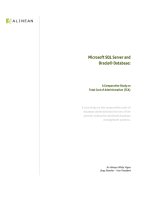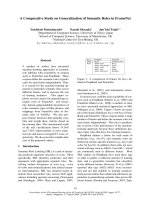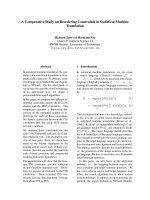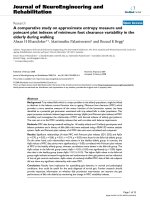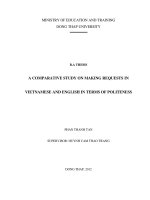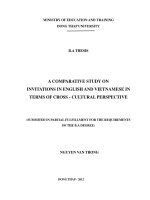A comparative study on rumah kanak kanak (children residential home) and rumah tunas harapan (foster home) in malaysia a child centric perspective
Bạn đang xem bản rút gọn của tài liệu. Xem và tải ngay bản đầy đủ của tài liệu tại đây (1.8 MB, 286 trang )
A COMPARATIVE STUDY ON RUMAH KANAK-KANAK
(CHILDREN RESIDENTIAL HOME) AND RUMAH TUNAS
HARAPAN (FOSTER HOME) IN MALAYSIA: A CHILD-
CENTRIC PERSPECTIVE
CHAN CHEONG CHONG
(BSW Mgt (Hons.), UUM; MA, UEA)
A THESIS SUBMITTED
FOR THE DEGREE OF DOCTOR OF PHILOSOPHY
DEPARTMENT OF SOCIAL WORK
NATIONAL UNIVERSITY OF SINGAPORE
2013
ii
DECLARATION
I hereby declare that the thesis is my original work
and it has been written by me in its entirety.
I have duly acknowledged all the sources of information which have been used
in the thesis.
This thesis has also not been submitted for any degree in any university
previously.
_________________
Chan Cheong Chong
16 December 2013
iii
ACKNOWLEDGEMENTS
This study would have not been possible without full support and approval
from the Economic Planning Unit Prime Minister’s Department of Malaysia,
the Social Welfare Department of Malaysia, the NUS Institutional Review
Board and the Department of Social Work, NUS.
Greatest appreciation for all the help from Mrs. Hajah Nor Amni (Former
Director of Children Division), Ms. Wan Zabariah (In charge of Children’s
Homes) and Ms. Rafidah (In charge of Foster Homes) at the Headquarter of
the Social Welfare Department of Malaysia.
A very big thank you to the very helpful and supportive principals, staff of the
children’s homes, and the foster parents.
My deepest gratitude to my supervisor, Dr. Choo Hyekyung and former
supervisor, Dr. Sudha Nair, for their patience, guidance, encouragement,
support and care.
Many thanks to A/P Dr. Esther Goh, A/P Dr. Irene Ng, Dr. Alex Lee, Mr. John
Ang, A/P Dr. Rosaleen Ow, A/P Dr. Maribeth Erb, Mr. Benny Bong and Ms
Boo Chui Ngoh for all the invaluable lessons, advice and assistance.
Special thanks to Mr. Hong Man Jiang, Dr. Xu Jian Bin, Ms Chung You Jin,
Dr. George, Dr. Peace Wong, Dr. Terence Yow, Ms. Joan Khng and many
other “social work” mates for their help and support.
Without the endless support from my wife (Siew Tau) and family members,
financial support from the Universiti Utara Malaysia, the Ministry of
Education Malaysia and the FASS Graduate Research Support Scheme, this
study would have not been possible.
Last but not least, I would like to dedicate this thesis to the 52 children who
had participated in this study. Wishing you all: A best future ahead!
iv
Table of Contents
Title
Page
Declaration
ii
Acknowledgments
iii
Table of Contents
iv
Summary
x
List of Tables
xi
List of Figures
xiii
List of Appendices
xiv
CHAPTER ONE: INTRODUCTION
1
International Perspective on Residential Child Care and Foster Care
3
Malaysian Perspective on Children’s Home and Foster Home
5
Current Issues Highlighted in Residential Child Care and Foster Care
13
The Purposes of the Study
17
Conclusion
18
CHAPTER TWO: LITERATURE REVIEW
19
Conceptual and Operational Definition
20
Foster Care
20
Residential Child Care
23
Behaviour of Children in Placement
24
The Severity of Behaviour Problems
25
Measuring the Behavioural Problems
27
Comparing Foster Care and Residential Child Care
29
Limitation of the Literature on Behaviour Issues
30
v
Education of Children in Placement
32
Instability in School
33
Poor Educational Attainment
35
Children’s Attitude towards Education
39
Limitation of the Literature on Education Issues
40
Health of Children in Placement
41
Trend in Researching Health Issues
42
Measuring the Health Condition
44
Health Examination
45
Accessibility to Health Services
46
Children’s Concern for Their Health
47
Limitation of the Literature on Health Issues
48
Placement Issues of Children in Placement
49
Children’s Perception on Their Placements
49
Children’s Choice of Placement if Given Power
54
Limitation of the Literature on Placement Issues
58
Discussion and Conclusion
59
CHAPTER THREE: RESEARCH FRAMEWORK AND QUESTIONS
62
Philosophical Stances
62
Theoretical Perspectives and Conceptual Framework
68
Symbolic Interactionism
69
Bronfenbrenner’s Ecological System Theory
73
Conceptual Framework
77
Research Questions
79
Conclusion
80
vi
CHAPTER FOUR: METHOD OF STUDY
81
Study Design
81
Sample of Study
84
Purposive Sampling
85
Criteria for Selection
86
Location of Study
87
Sampling Process
88
The 52 Participants
92
Data Collection
97
Questions in Interview Guide
98
The Interviews
100
Data Analysis
102
Transcription and Translation
106
Credibility and Reliability
107
Ethical Consideration
109
Informed Consent
110
Lessons Learned from the 52 Interviews
113
Conclusion
114
CHAPTER FIVE: RESULTS
115
Behaviour
119
Uncontrollable Offensive Behaviours: “Babi, Bodoh, Pukimak!”
120
Desperate Behaviours: Money or Food
124
Protective Behaviours
126
Cooperative Behaviours
129
Similarities and Differences
132
vii
Education
135
Academic Stereotype and Discrimination
135
Unjustifiable Harsh Treatment
140
Scarcity of Substantive Educational Support
142
Support in Schools
142
Support in Foster Homes
145
Support in Children’s Homes
146
Escapism: From Old Trouble to New Trouble
148
Similarities and Differences
152
Health
155
Problems in Disguise
155
Untold Help Seeking Strategies
157
Foster Mothers
157
Staff Mothers and Nurses
159
Friends as Messengers
160
Children Who Did Not Seek Help
163
Similarities and Differences
165
Placement
168
Acceptance of Current Home
168
Liking or Disliking Foster Homes Because of Foster Mothers
169
Disliking Children’s Homes Because of Staff
172
Liking or Disliking Both Homes Because of Activities
176
Disliking Both Homes Because of Peers
177
Liking or Disliking Both Homes Because of Facilities
178
Choices of Future Home
181
Family Reunification as Most Wanted but Most Problematic
Choice
181
viii
Foster Home as Popular and Workable Choice
184
Children’s Home as Most Unwelcome but Reliable Choice
186
Similarities and Differences
187
Future Aspiration
190
Entering University
190
Becoming a Police Officer
193
Similarities and Differences
195
Conclusion
196
CHAPTER SIX: DISCUSSION
197
Initial Framework of Reciprocal Interaction and Self-Indication
197
Behaviour
198
Education
199
Health
201
Placement
202
Future Aspiration
204
Caveat of the Initial Framework
205
New Insights from Conflict Perspective
207
Dichotomous Position and Power Relation
208
Interpersonal Conflicts
210
Child vs. School Teacher or Schoolmate: Academic Stereotype and
Discrimination
210
Child vs. Caregiver: Untold Help Seeking Strategies and
Acceptance of Current Placement
211
Child vs. Peer: Offensive, Desperate, Protective and Cooperative
Behaviours
214
Intrapersonal Conflicts
217
The Revised Framework
219
ix
Patterns of Experiences and Views
222
Theoretical Question
225
Conclusion
227
CHAPTER SEVEN: RECOMMENDATIONS AND CONCLUSION
228
Recommendations
228
Recommendations for Practice
228
Group Activities
229
Individual Casework
230
Specific Recommendation for Foster Homes
233
Specific Recommendation for Children’s Homes
234
Recommendations for Policy
234
Recommendations for Future Studies
236
Contributions of the Study
238
Limitations of the Study
239
Conclusion
241
References
243
Appendices
273
x
Summary
Foster care is relatively unknown in Malaysia as compared to the popular
residential child care. Almost no studies on foster care can be found in the
local context. Although many studies have been conducted in the Western
countries, many of the studies barely compare children who reside in both
foster care and residential child care. Indeed, many of the studies adopted
quantitative approach, which limits the availability of contextual data from the
children’s perspective. Hence, this study used a qualitative approach to
explore experiences and views of the Malaysian children who stay at state-run
children’s homes and foster homes. Twenty-five foster children and 27
children in children’s homes, aged 10 to 15, were purposively selected for
interview and compared on their experiences and views. Based on the
children’s narratives, 14 themes were generated in the five domains of
behaviour, education, health, placement and future aspiration. Some important
themes are offensive, desperate, protective and cooperative behaviours;
academic stereotype and discrimination; untold help seeking strategies;
acceptance of current placement. These themes are not fully articulated by an
initial framework of Symbolic Interactionism and Bronfenbrenner’s
Ecological System Theory, but are explainable from a new perspective of
conflict. Overall, more foster children were found to have better experiences
and views as compared to their counterparts in children’s homes. The
differences are attributed to the children’s reciprocal interactions and the
intensity of interpersonal and intrapersonal conflicts. Consequently, group
activities and individual social casework are interventions that could help the
homes in facilitating positive interactions and reducing conflict instances
between and among the children and the related actors. In addition,
recommendations for policy and future studies such as to develop a child-
centric home and to verify the research framework are highlighted.
xi
List of Tables
Table
Title
Page
1
Comparison between Children’s Home and Foster Home
9
2
Characteristics of Foster Care in Malaysia As Compared to Other
Countries
21
3
Group Homes and Foster Home
23
4
Subtle Realism and Subtle Idealism
63
5
Blumer’s Three Premises
70
6
Bronfenbrenner’s Ecological System Theory
75
7
Population in Children’s Homes (2005-2006) and Foster Homes
(2007)
84
8
Total Residents in Three Children’s Homes and Five Foster Homes
(as recorded in 30 April 2010)
88
9
Children in Children’s Homes who fulfilled the Criteria of Selection
89
10
Foster Children who fulfilled the Criteria of Selection
89
11
Children’s Homes
90
12
Foster Homes
91
13
Participants from the Children’s Homes
93
14
Participants from the Foster Homes
94
15
Participants from Both Homes
95
16
Causes of Placement
95
17
Number of Placements
96
18
Previous Placements
97
19
Interpreting the Interview Data from Narrative Approach
104
20
Patterns of Experiences and Views among the Foster Children
115
21
Patterns of Experiences and Views among the Children in
Children’s Homes
117
22
Five Domains and 14 Themes
118
xii
23
Similarities and Differences in Behaviour Issues
133
24
Similarities and Differences in Education Issues
152
25
Similarities and Differences in Health Issues
165
26
Immediate Response on Current Home
168
27
Future Home
181
28
Similarities and Differences in Placement Issues
187
29
Similarities and Differences in Future Aspiration
196
30
The Benefits of an Alternative Home
235
xiii
List of Figures
Figure
Title
Page
1
The development and locations of public children’s homes in
peninsular Malaysia.
7
2
The development and locations of foster homes under the Rumah
Tunas Harapan Project.
11
3
Position of children’s home and foster home in Malaysia.
12
4
Illustration of Symbolic Interactionism on the process and outcomes
of the placement.
73
5
Conceptual framework of the study that combines the Symbolic
Interactionism and the Bronfenbrenner’s Ecological System Theory.
78
6
Research design modified from and inspired by Mason (2002, p.
72).
83
7
Sampling process of recruiting the 52 participants.
92
8
The process of analyzing and making sense of the data.
105
9
The continuum of behaviours patterns.
134
10
The continuous loop of poor academic performance.
154
11
Untold help-seeking strategies in health.
166
12
Children’s acceptance and choices of homes.
189
13
Power play of a child by changing an initial goal to a new goal.
212
14
The revised framework.
221
15
Patterns of experiences and views among the foster children.
223
16
Patterns of experiences and views among the children in children’s
homes.
225
xiv
List of Appendices
Appendix
Title
Page
A
Profile of 52 Children
273
B
Interview Guide
277
C
Approval Letter from Economic Planning Unit (EPU)
282
D
EPU Research Pass
284
E
Approval Letter 1 from Social Welfare Department of Malaysia
285
F
Approval Letter 2 from Social Welfare Department of Malaysia
288
G
Approval to Conduct Research at NUS
291
H
NUS IRB Approval Certificate
292
I
Approval of Protocol Amendment 1
294
J
Participant Information Sheet and Consent Form (NUS IRB
Approved)
295
K
Child Information Sheet (NUS IRB Approved)
299
1
CHAPTER ONE: INTRODUCTION
Residential care and foster care are two popular substitute care
alternatives for children who are separated from their families. The
development of both types of substitute care can be traced to England as early
as the 15
th
century (Frost, Mills, & Stein, 1999). As both of these substitute
care alternatives have evolved, an endless debate has erupted about whether
the Child Care model or the House Parent model provides the best care for the
children (Jones, Landsverk, & Roberts, 2007). While the Child Care model
advocates care in an institutional setting such as a children’s home, the House
Parent model promotes care in a family environment such as a foster home,
group home or foster family (Jones, Landsverk, & Roberts, 2007). Although
extensive research work has been conducted on both residential care and foster
care, studies that have directly compared the two types of substitute care are
limited (e.g., Farmer, Mustillo, Burns, & Holden, 2008). Moreover, many of
these studies were conducted in a Western context.
Many Western countries, such as the United States, the United
Kingdom and Sweden, widely provide foster care (Andersson, 2005; Kendrick,
2008; U.S. Children’s Bureau, 2007). Conversely, some Asian countries,
namely, Japan and Malaysia, mainly provide residential care (Colton &
Roberts, 2007). In Malaysia, foster care was introduced officially in 1988 with
the establishment of the first Tunas Harapan Foster Home. For the past
twenty-five years, residential care has overshadowed foster care, while the
public has negatively perceived residential care due to its poor environment
which is known as “less-than-ideal” placement (Raj & Raval, 2013, p. 203).
As a result, limited research has been conducted on foster care in Malaysia,
2
and empirical evidence from the children’s perspective in residential care is
limited in Malaysia (Nor Amni Yusof, personal communication, June 16,
2008).
Some have claimed that children are neither included in studies nor
given sufficient opportunity to express their ideas about their placements
(Chapman, Wall, & Bath, 2004; Kaplan, Skolnik, & Turnbull, 2009; McAuley,
1996; Whiting & Lee, 2003). Information about the children is mostly
gathered from caregivers and agencies. To address this limitation, a child-
centric perspective has been advocated gradually in residential care and foster
care studies. This perspective promotes direct and active participation from the
children. Studies using this perspective have provided a different side of the
story as compared with that of the conventional adult perspective (Mckenzie,
1999a; Sinclair & Gibbs, 1998; Watson & West, 2001). In view of this, a
child-centric perspective is proposed to compare residential care (children’s
home) and foster care (foster home) in Malaysia. Such a study would provide
significant evidence to improve the quality of residential care and foster care
services in Malaysia.
In brief, this is a child-centric study which focuses on experiences and
views of children who stay at Rumah Kanak-Kanak (children residential home)
and Rumah Tunas Harapan (foster home). The following sections review in
detail the development of residential care and foster care, and popular issues
studied in many research projects. In line with these reviews, specific purposes
of this study are presented.
.
3
International Perspective on Residential Child Care and Foster Care
The history of placing children, who are separated from their families,
in residential child care and foster care actually comes from the same root. The
foster care idea can be traced to as early as 1536 in England as part of
apprentice activities for vagrant children (Frost, Mills, & Stein, 1999), while
residential child care appeared through the establishment of institutional child
care, Christ’s Hospital, in London by 1552 (Frost, Mills, & Stein, 1999).
By the 19
th
century, orphanages had been established in Germany
(Frommann, Haag, & Trede, 1991), England and Wales (Frost, Mills, & Stein,
1999), the United States (DeSaussure, 1891 in Olasky, 1999), and Scotland
(Millar, 2007). The most significant development of residential child care at
that time was the effort of Thomas Barnardo, who introduced Cottage Boys
Home and Girls Home (Frost, Mills, & Stein, 1999). In effect, residential child
care was a phenomenon of 19
th
century (London, 1999).
In the early 20
th
century, especially during the Great Depression,
residential child care was gradually perceived as high cost and difficult to
manage. As a result, many looked-after children from England and Wales
were sent out to British Colonies around the world (Millar, 2007). Affected
institutions for children in the United States emptied their beds by sending out
their children to individuals with free homes (Creagh, 2006). Since the Second
World War, however, the face of child placements has changed considerably.
After the war, a growing concern for “normalisation” and “remain together
with the family” arose (Hendrick, 1994). This development was related closely
to one researcher, John Bowbly (Frost, Mills, & Stein, 1999; Hendrick 1994).
4
Bowbly’s study on attachment provided significant justification for the
importance of foster care (Frost, Mills, & Stein, 1999; Hendrick, 1994).
In the 1960s, the publicity of Dr. C. Henry Kempe’s “battered-child
syndrome”
1
incidents in the United States and the increased availability of
public funding facilitated more foster care placements (Hendrick, 1994; Ip,
2000; Jal Zabdi Mohd Yusoff, 2008; Olasky, 1999) and the decline of
residential child care placements (London, 1999). In the 1970s, this
development continued and was reinforced by scandals (institutional abuse),
problems of cost, and the permanency movement in the United States (Barter,
2006; McAuley, 1996). In 1972, the number of residents in children’s homes
in England and Wales declined to 20,000 (Frost, Mills, & Stein, 1999). By
March 31, 2005, only 13.3% children out of home were placed in residential
child care in the United Kingdom (Kendrick, 2008). Today, the majority of
children out of home in England and in the United States are placed in foster
care (Department of Health 2001 and 2008; U.S. Children’s Bureau, 2007).
Nevertheless, since the late 1980s, residential child care has gradually
received positive responses due to an advocacy movement starting from that
period (London, 1999). More and more positive findings in research (Frost,
Mills, & Stein, 1999) and policy development (Kay, Kendrick, Stevens, &
Davidson, 2007) favouring residential child care were produced. For instance,
Andersson (2005) found that residential child care provided no significant
differences with respect to child well-being as compared to other forms of care,
whereas McKenzie (1999b) commented that foster care is actually becoming
“permanent temporary care” for most children and is the worst care ever (p. 1).
1
“A clinical condition in young children who have received serious physical abuse, generally
from a parent or foster parent” (Kempe, Silverman, Steele, Droegemueller, & Silver, 1985,
p.143).
5
The quality of living standard in residential child care has been improved
significantly throughout the years (Gibson, Leonard, & Wilson, 2004).
Reports have noted that residential child care has not been totally abandoned
in England and Scotland (Dixon, 2008). In other countries like Japan,
residential child care is still the dominant substitute care, which
accommodates 90% of children out of home (Colton, & Roberts, 2007).
To sum up, the development of residential child care and foster care
are affected highly by particular incidents, research findings, environment
conditions and time factors. Thus, it is unempirical to claim that foster care is
the most popular method in contemporary practice without considering the
latest developments in residential child care.
Malaysian Perspective on Children’s Home and Foster Home
The earliest formal child placement practice in Malaysia is associated
mostly with the establishment of children’s homes. For instance, under British
influence, St. Joseph’s Orphanage was established in 1865 in Penang (Fulcher
& Faizah Mas’ud, 2001). Starting from this original orphanage, missionary
groups and non-governmental organizations built more and more residential
children institutions all over the country (Fulcher & Faizah Mas’ud, 2001).
Before 1957, the development of residential child care was designed
and determined mainly by British Colonial rule. According to Fulcher and
Faizah Mas’ud (2001), the residential child care development in Malaysia was
shaped strongly by the British during the period of 1948 to 1960, an era of
Malayan emergency of guerrilla war against local communist terrorists. The
6
influence of the British in Malaysian child welfare continued after
independence through “the tradition of Britain-trained professionals or those
trained in the British tradition in Singapore” (Fulcher & Faizah Mas’ud, 2001).
Thus, some contemporary legislation such as the Juvenile Courts Act 1947
(ended in 2001) and practices of child welfare still dated from the British
colonial government (Fulcher & Faizah Mas’ud, 2001).
Residential child care is traditionally perceived as the most popular
substitute care in Malaysia. There are two types of children’s homes in
Malaysia; these are public children’s homes and non-profit private children’s
homes. Public children’s homes are fully managed by the Social Welfare
Department of Malaysia, while private children’s homes are managed by
missionary agencies (e.g., The Salvation Army) or ethnically based non-
governmental organizations.
Figure 1 below illustrates the development and locations of eight
public children’s homes in peninsular Malaysia, and the homes barely cope
with the increasing number of children in need of placement (Social Welfare
Department of Malaysia, 2009b; Social Welfare Department of Malaysia,
2012; Nor Amni Yusof, personal communication, October 19, 2009; UNICEF,
2006). In the early years, each public children’s home (Rumah Kanak-Kanak)
was designed to accommodate 100 children (Social Welfare Department of
Malaysia, 2009a). Since 2002, the actual number of residents in public
children’s homes has exceeded the capacity limit (Ministry of Women, Family
and Community Development, 2007; Social Welfare Department of Malaysia,
2001 and 2002). Under the new National Child Protection Policy 2009, each
of the public children’s homes is required to officially declare its commitment
7
to upholding child protection guidelines, namely, practising the correct
working attitude with children, proper screening of recruitment of staff and
volunteers, and providing training and supervision (Ministry of Women,
Family and Community Development, 2008b).
Figure 1.The development and locations of public children’s homes in
peninsular Malaysia.
Limited published records and historical details exist on foster care
activities in Malaysia, although kinship care activities are quite well known.
Foster care has grown steadily without much popularity as compared to
adoption (refer Lai, 1998). Indeed, legal definition of foster care is unavailable
in Malaysia (Azizah Mohd & Nadhilah A. Kadir, 2012). However, practice of
the Social Welfare Department of Malaysia shows that there are three different
types of foster care in Malaysia. The first type is that commonly known in the
United States as family foster care. This is the typical type of foster care in
which children are placed into a non-biological family. In Malaysia UNICEF
(2006) reported 148 foster parents in this category. These foster parents
receive from RM250 allowance for a foster child and up to a maximum RM
1935
Malacca
1959
Serendah
1962
Kuala
Kangsar
1963
Kuantan
1964
Cheras
1969
Kepala
Batas
2001
Arau
2009
Rembau
1930
2011
8
500 per month. After two years of fostering, the foster parent can apply to
adopt the child.
The second type of foster care in Malaysia is kinship care. UNICEF
(2006) defines kinship care as a “full-time nurturing and protection of a child
by relatives, members of a tribe or clan, godparents, step-parents, or other
adults who have a kinship bond with a child” (p. 26). In Malaysia, some
kinship care families are eligible to apply for financial assistance from the
Social Welfare Department.
The third type of foster care in Malaysia is the foster home that is the
main focus of this study. Foster home care refers to a structural foster care
institution initiated by the government. It is a children’s institution that
delivers care in a family environment and is represented by the Rumah Tunas
Harapan. The foster home program was started in 1988 by the Social Welfare
Department of Malaysia through a project known as The Family System
Children’s Home (Faizah Mohd Tahir, 2004) or The Family/Cottage System
of Care (UNICEF, 2006). In this project, a group of 8 to 10 children are placed
under the care of a married couple (foster parents) in a house contributed by
the private sector and supported by the Social Welfare Department and local
communities (UNICEF, 2006). Foster parents in a foster home receive
RM1000 of allowance per month (Abdullah Ahmad Badawi, 2008). The
husband is allowed to have full-time employment, while the wife must be a
full time housewife.
Table 1 shows several differences in services provided exist between
Rumah Kanak-Kanak (public children’s home) and Rumah Tunas Harapan
(foster home) in Malaysia (Nor Amni Yusof, personal communication, June
9
16, 2008; Social Welfare Department of Malaysia, 2002; Social Welfare
Department of Malaysia, 2009a; Social Welfare Department of Malaysia, n.d.).
The foster home provides care in a family environment with foster parents,
with low density to ensure sufficient care for and attention to every child and
permanency orientation. The children’s home emphasises protective care for
children in need (e.g., being harmed by others or having dysfunctional parents)
and is mostly temporary until foster care, adoption or family reunification can
be achieved. Furthermore, a children’s home accommodates and receives all
kinds of children who are in need of protection. Conversely, a foster home
does not take in children below age 6 and mostly accepts children who were
abandoned or orphaned or children from families with financial difficulties.
Both homes are arranged and managed by the Social Welfare Department of
Malaysia.
Table 1
Comparison between Children’s Home and Foster Home
Characteristics
Children’s Home
Foster Home
1.
Age of children
Less than 18 years of
age
Ages 6 -18
2.
Setting
Institution
House
3.
No. of Children in
care per residence
100 residents
10 children
4.
Title of Caregiver
Staff/Staff Mom
Foster Parent
5.
Admission
Children in need of
protection
Abandoned children or
orphans, families with
financial difficulties
6.
Arranged and
Managed by
Social Welfare
Department
Social Welfare
Department
10
Chong (1991) explained well the policy shifts to the foster home from
the children’s home. She wrote that it is always the priority of the Social
Welfare Department of Malaysia to provide family care for the children
because growing up in a family environment setting is important. Her claim is
accounted for in the latest Child Act 2001 in which the family is
acknowledged as the basic unit for the development and growth of children.
Unfortunately, the public’s willingness to foster children in need who are
three-years old and above in their own houses is very low (Nor Amni Yusof,
personal communication, June 16, 2008; Social Welfare Department of
Malaysia, 2002). Thus, Rumah Tunas Harapan was introduced to facilitate
more substitute care in a family setting and also for permanency purposes.
These objectives have been further reinforced through the latest National
Child Policy 2009. According to the targets of this policy, the number of foster
families to provide temporary care for out of home children is to be increased
by 2% every year starting from 2009 (Ministry of Women, Family and
Community Development, 2008a).
In 1988, the first Rumah Tunas Harapan was set up at Kuala Selangor
with four units of semi-detached houses (Chong, 1992). At that time, 40
children were placed in four families with 15 of them being primary school
children, 24 secondary school children and one pre-school age child (Chong,
1992).
The second Rumah Tunas Harapan was established four years later.
Today, after twenty years, there are eight foster homes with 26 houses in
Malaysia. Figure 2 below shows the development and locations of the foster
homes in Malaysia (Nor Amni Yusof, personal communication, October 19,
11
2009; Social Welfare Department of Malaysia, 2009c; Social Welfare
Department of Malaysia, n.d.).
Figure 2. The development and locations of foster homes under the Rumah
Tunas Harapan project.
Foster homes and children’s homes play significant roles in delivering
care to children in placement. Both types of home have their own unique
positions in the child placement system in Malaysia. Figure 3 below illustrates
the position of both homes within the system (Azizah Mohd & Nadhilah A.
Kadir, 2012; Child Act 2001; Nor Amni Yusof, personal communication, June
16, 2008).
According to the Child Act 2001 Section 30 (1) (d), a public children’s
home is the common remedy for children who are separated from their
families. However, children’s homes are designed to be temporary, and
children’s reunion with their biological families is to be facilitated. If the
biological parents are unavailable or cannot be traced, the children can be
placed into foster care under the Child Act 2001 Section 30 (1) (e).
1985
2011
1988
Kuala
Selangor
6 houses
1992
Kuala Pilah
4 houses
1993
Kuala
Terengganu
4 houses
1999
Sungai
Buloh
4 houses
2003
Jengka
2 houses
2006
Bukit
Beruntung
1 house
2009
Seri
Kembangan
1 house
1998
Jasin 2 houses
Kota Bharu 2 houses
